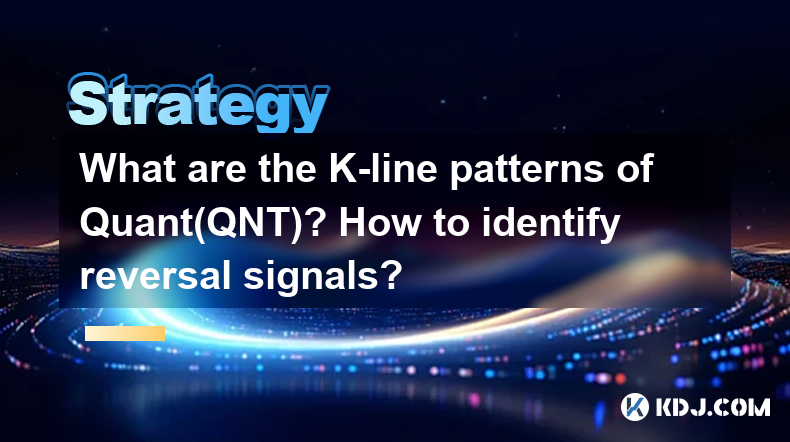-
 bitcoin
bitcoin $110047.851143 USD
-1.37% -
 ethereum
ethereum $3727.617466 USD
-1.30% -
 tether
tether $1.000961 USD
-0.05% -
 bnb
bnb $1114.045467 USD
1.72% -
 xrp
xrp $2.343280 USD
0.14% -
 solana
solana $174.674876 USD
-5.85% -
 usd-coin
usd-coin $0.999999 USD
0.02% -
 tron
tron $0.311757 USD
-2.44% -
 dogecoin
dogecoin $0.183678 USD
-3.76% -
 cardano
cardano $0.627109 USD
-2.07% -
 ethena-usde
ethena-usde $1.000300 USD
0.15% -
 hyperliquid
hyperliquid $36.865760 USD
-2.74% -
 chainlink
chainlink $16.968918 USD
-1.48% -
 stellar
stellar $0.318159 USD
0.47% -
 bitcoin-cash
bitcoin-cash $500.637224 USD
-1.56%
What are the K-line patterns of Quant(QNT)? How to identify reversal signals?
K-line patterns like hammer and bullish engulfing can signal potential price reversals in Quant (QNT), aiding traders in making informed decisions.
May 06, 2025 at 06:43 pm

Introduction to K-line Patterns of Quant (QNT)
K-line patterns, also known as candlestick patterns, are essential tools for traders in the cryptocurrency market. For Quant (QNT), understanding these patterns can provide insights into market sentiment and potential price movements. This article delves into the various K-line patterns observed in QNT trading and how to identify reversal signals, equipping traders with the knowledge to make informed decisions.
Common K-line Patterns in Quant (QNT)
K-line patterns are graphical representations of price movements within a specific timeframe. For Quant (QNT), several patterns are frequently observed and can be categorized into bullish, bearish, and neutral patterns. Understanding these patterns is crucial for identifying potential trends and reversals.
Bullish Patterns
Bullish patterns indicate a potential upward trend in the price of Quant (QNT). Some common bullish patterns include:
- Hammer: A hammer pattern forms when the price opens, drops significantly, but then recovers to close near the opening price. This pattern suggests that buyers are stepping in to push the price up after a decline, signaling a potential reversal.
- Bullish Engulfing: This pattern occurs when a small bearish candle is followed by a larger bullish candle that completely engulfs the previous candle's body. It indicates a strong shift in momentum from sellers to buyers.
- Morning Star: A morning star pattern consists of three candles: a long bearish candle, a small-bodied candle (which can be bullish or bearish), and a long bullish candle. This pattern suggests a reversal from a downtrend to an uptrend.
Bearish Patterns
Bearish patterns indicate a potential downward trend in the price of Quant (QNT). Some common bearish patterns include:
- Shooting Star: A shooting star pattern forms when the price opens, rises significantly, but then falls to close near the opening price. This pattern suggests that sellers are stepping in to push the price down after an increase, signaling a potential reversal.
- Bearish Engulfing: This pattern occurs when a small bullish candle is followed by a larger bearish candle that completely engulfs the previous candle's body. It indicates a strong shift in momentum from buyers to sellers.
- Evening Star: An evening star pattern consists of three candles: a long bullish candle, a small-bodied candle (which can be bullish or bearish), and a long bearish candle. This pattern suggests a reversal from an uptrend to a downtrend.
Neutral Patterns
Neutral patterns do not strongly indicate a trend direction but can provide insights into market consolidation. Some common neutral patterns include:
- Doji: A doji pattern forms when the opening and closing prices are virtually the same, creating a small or non-existent body. This pattern suggests indecision in the market and can signal a potential reversal or continuation depending on the context.
- Spinning Top: A spinning top pattern is similar to a doji but has a slightly larger body. It also indicates market indecision and can signal a potential change in trend direction.
Identifying Reversal Signals in Quant (QNT)
Identifying reversal signals in Quant (QNT) involves recognizing specific patterns and confirming them with additional technical indicators. Here’s how to identify and confirm these signals:
Recognizing Reversal Patterns
- Look for the patterns: Start by identifying the bullish and bearish patterns mentioned earlier. For instance, a hammer or a bullish engulfing pattern in a downtrend might signal a potential bullish reversal.
- Confirm with volume: High trading volume accompanying the reversal pattern can validate the signal. For example, a bullish engulfing pattern with increased volume suggests strong buying interest.
Using Technical Indicators
- Moving Averages: Use moving averages to confirm the trend direction. A bullish reversal signal is more reliable if it occurs when the price crosses above a key moving average, such as the 50-day or 200-day moving average.
- Relative Strength Index (RSI): The RSI can help confirm overbought or oversold conditions. A bullish reversal signal is more reliable if the RSI is below 30 (indicating oversold conditions) and starts to rise.
- MACD (Moving Average Convergence Divergence): The MACD can confirm momentum changes. A bullish reversal signal is more reliable if the MACD line crosses above the signal line.
Practical Example of Identifying a Reversal Signal
Let’s consider a practical example of identifying a bullish reversal signal in Quant (QNT):
- Identify the pattern: You notice a hammer pattern forming at the end of a downtrend on the daily chart of QNT.
- Check the volume: The hammer pattern is accompanied by a significant increase in trading volume, suggesting strong buying interest.
- Confirm with technical indicators: The price of QNT is below the 50-day moving average, and the RSI is at 28, indicating oversold conditions. Additionally, the MACD line has just crossed above the signal line.
- Conclusion: Given these factors, the hammer pattern is a strong bullish reversal signal, suggesting that the price of QNT may start to rise.
Trading Strategies Based on K-line Patterns
Using K-line patterns to develop trading strategies for Quant (QNT) involves setting clear entry and exit points based on the identified signals. Here’s how to implement these strategies:
Entry Points
- Bullish Reversal: Enter a long position when a bullish reversal pattern is confirmed by high volume and technical indicators. For example, enter a long position after a bullish engulfing pattern with increased volume and a bullish MACD crossover.
- Bearish Reversal: Enter a short position when a bearish reversal pattern is confirmed by high volume and technical indicators. For example, enter a short position after a bearish engulfing pattern with increased volume and a bearish MACD crossover.
Exit Points
- Take Profit: Set take-profit levels based on key resistance levels or Fibonacci retracement levels. For example, if you enter a long position after a bullish reversal, set your take-profit at the next significant resistance level.
- Stop Loss: Set stop-loss levels to manage risk. For example, if you enter a long position after a bullish reversal, set your stop-loss below the low of the reversal pattern to limit potential losses.
Practical Steps to Trade Quant (QNT) Using K-line Patterns
Here are the detailed steps to trade Quant (QNT) using K-line patterns:
- Choose a reliable trading platform: Select a platform that offers real-time data and charting tools, such as Binance or Coinbase Pro.
- Set up your chart: Open the QNT chart and set the timeframe to your preferred interval (e.g., daily, 4-hour, 1-hour).
- Identify the pattern: Scan the chart for bullish or bearish reversal patterns. For example, look for a hammer pattern at the end of a downtrend.
- Confirm the signal: Check the volume and technical indicators to confirm the reversal signal. Ensure that the volume is high and that the RSI and MACD support the reversal.
- Enter the trade: Once the signal is confirmed, enter the trade at the appropriate entry point. For a bullish reversal, enter a long position; for a bearish reversal, enter a short position.
- Set stop-loss and take-profit levels: Set your stop-loss and take-profit levels based on key support and resistance levels or technical indicators.
- Monitor the trade: Keep an eye on the trade and adjust your stop-loss and take-profit levels as needed based on market conditions.
Frequently Asked Questions
Q: Can K-line patterns be used for short-term trading of Quant (QNT)?A: Yes, K-line patterns can be effectively used for short-term trading of Quant (QNT). Traders often use shorter timeframes, such as 1-hour or 15-minute charts, to identify these patterns and execute quick trades. However, it’s important to confirm these patterns with volume and technical indicators to increase the reliability of the signals.
Q: How reliable are K-line patterns in predicting price movements of Quant (QNT)?A: K-line patterns can be reliable indicators of potential price movements when used in conjunction with other technical analysis tools. While no single pattern guarantees a specific outcome, combining patterns with volume analysis and technical indicators like RSI and MACD can enhance their predictive power.
Q: Are there any specific K-line patterns that are more effective for Quant (QNT) than others?A: The effectiveness of K-line patterns can vary depending on market conditions and the specific asset. For Quant (QNT), patterns like the hammer, bullish engulfing, and bearish engulfing have been observed to be particularly effective due to their clear signals and frequent occurrence. However, traders should always confirm these patterns with additional analysis.
Q: How can I improve my skills in identifying K-line patterns for Quant (QNT)?A: Improving your skills in identifying K-line patterns involves practice and continuous learning. Here are some tips:
- Practice on historical data: Use historical charts of Quant (QNT) to practice identifying patterns and confirming them with volume and technical indicators.
- Use educational resources: Read books, watch tutorials, and participate in trading courses focused on candlestick patterns and technical analysis.
- Join trading communities: Engage with other traders to share insights and learn from their experiences in trading Quant (QNT) using K-line patterns.
Disclaimer:info@kdj.com
The information provided is not trading advice. kdj.com does not assume any responsibility for any investments made based on the information provided in this article. Cryptocurrencies are highly volatile and it is highly recommended that you invest with caution after thorough research!
If you believe that the content used on this website infringes your copyright, please contact us immediately (info@kdj.com) and we will delete it promptly.
- XRP Price Prediction: Weekend Rollercoaster or Rally?
- 2025-10-12 08:45:16
- Bittensor (TAO): Super Bullish Signals Point to Potential 2x Rally
- 2025-10-11 10:25:12
- Silver Price Correction: Navigating the Dip & Identifying Key SEO Keywords
- 2025-10-11 10:25:12
- Decoding Crypto Trends: Bittensor's Bull Run, Cardano's Dip, and LivLive's Presale Buzz in 'Uptober 2025'
- 2025-10-12 08:45:16
- MoonBull: The Crypto Meme Coin Promising 1000x Gains?
- 2025-10-11 10:30:01
- Crypto Payroll Revolution: Stablecoins, Altcoins, and the Future of Salary Payments
- 2025-10-11 10:30:01
Related knowledge

Practical parameter settings for a Bitcoin multi-timeframe moving average system
Sep 18,2025 at 10:54pm
Optimizing Timeframe Combinations for Bitcoin Trading1. Selecting appropriate timeframes is crucial when building a multi-timeframe moving average sys...

How can I filter out false breakouts in Dogecoin high-frequency trading?
Sep 22,2025 at 01:00am
Understanding False Breakouts in Dogecoin Trading1. A false breakout occurs when Dogecoin's price appears to move beyond a defined support or resistan...

Techniques for identifying tops and bottoms in the Bitcoin on-chain NVT model
Sep 20,2025 at 07:54pm
Understanding the NVT Model in Bitcoin Analysis1. The Network Value to Transactions (NVT) ratio is often described as the 'P/E ratio' of the cryptocur...

What does the surge in open interest in Bitcoincoin futures mean?
Sep 20,2025 at 11:18pm
Understanding the Surge in Dogecoin Futures Open Interest1. A surge in open interest within Dogecoin futures indicates a growing number of active cont...

How can I use the Ethereum USDT premium to gauge market sentiment?
Sep 18,2025 at 11:55pm
Understanding the Ethereum USDT Premium1. The Ethereum USDT premium refers to the price difference between USDT (Tether) traded on Ethereum-based plat...

What should I do if Ethereum staking yields decline?
Sep 20,2025 at 06:18am
Understanding the Causes Behind Declining Ethereum Staking Yields1. The Ethereum network transitioned to a proof-of-stake consensus mechanism with the...

Practical parameter settings for a Bitcoin multi-timeframe moving average system
Sep 18,2025 at 10:54pm
Optimizing Timeframe Combinations for Bitcoin Trading1. Selecting appropriate timeframes is crucial when building a multi-timeframe moving average sys...

How can I filter out false breakouts in Dogecoin high-frequency trading?
Sep 22,2025 at 01:00am
Understanding False Breakouts in Dogecoin Trading1. A false breakout occurs when Dogecoin's price appears to move beyond a defined support or resistan...

Techniques for identifying tops and bottoms in the Bitcoin on-chain NVT model
Sep 20,2025 at 07:54pm
Understanding the NVT Model in Bitcoin Analysis1. The Network Value to Transactions (NVT) ratio is often described as the 'P/E ratio' of the cryptocur...

What does the surge in open interest in Bitcoincoin futures mean?
Sep 20,2025 at 11:18pm
Understanding the Surge in Dogecoin Futures Open Interest1. A surge in open interest within Dogecoin futures indicates a growing number of active cont...

How can I use the Ethereum USDT premium to gauge market sentiment?
Sep 18,2025 at 11:55pm
Understanding the Ethereum USDT Premium1. The Ethereum USDT premium refers to the price difference between USDT (Tether) traded on Ethereum-based plat...

What should I do if Ethereum staking yields decline?
Sep 20,2025 at 06:18am
Understanding the Causes Behind Declining Ethereum Staking Yields1. The Ethereum network transitioned to a proof-of-stake consensus mechanism with the...
See all articles










































































